Heinrich J.G., Aldinger F. (Eds.) Ceramic Materials and Components for Engines
Подождите немного. Документ загружается.


This Page Intentionally Left Blank
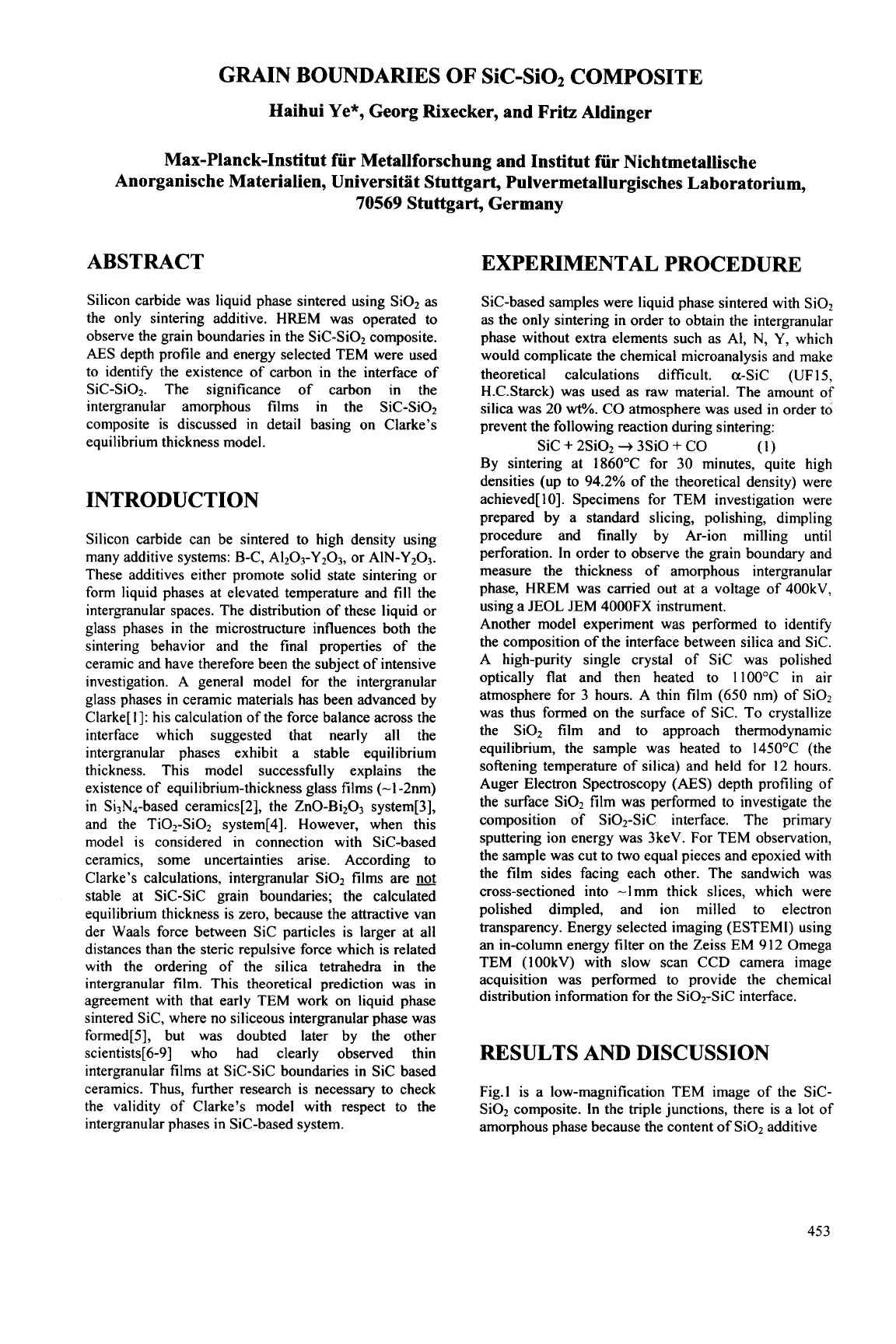
GRAIN BOUNDARIES
OF
SiC-Si02 COMPOSITE
Haihui Ye*, Georg Rixecker, and
Fritz
Aldinger
Max-Planck-Institut fur Metallforschung and Institut fur Nichtmetallische
Anorganische Materialien, Universitat Stuttgart, Pulvermetallurgisches Laboratorium,
70569
Stuttgart, Germany
ABSTRACT
Silicon carbide was liquid phase sintered using Si02
as
the only sintering additive. HREM was operated to
observe the grain boundaries in the Sic-Si02 composite.
AES
depth profile and energy selected TEM were used
to identify the existence of carbon in the interface of
SiC-Si02. The significance of carbon in the
intergranular amorphous films in the Sic-Si02
composite is discussed in detail basing on Clarke’s
equilibrium thickness model.
INTRODUCTION
Silicon carbide can be sintered to high density using
many additive systems: B-C, AI2O3-Y2O3,
or
AIN-Y203.
These additives either promote solid state sintering
or
form liquid phases at elevated temperature and fill the
intergranular spaces. The distribution of these liquid
or
glass phases in the microstructure influences both the
sintering behavior and the final properties of the
ceramic and have therefore been the subject of intensive
investigation. A general model for the intergranular
glass phases in ceramic materials has been advanced by
Clarke[
I]:
his calculation of the force balance across the
interface which suggested that nearly all the
intergranular phases exhibit a stable equilibrium
thickness. This model successfully explains the
existence of equilibrium-thickness glass films (-1 -2nm)
in
Si3N4-based ceramics[2], the ZnO-Bi203 system[3],
and the TiOz-Si02 system[4]. However, when this
model is considered in connection with Sic-based
ceramics, some uncertainties arise. According to
Clarke’s calculations, intergranular Si02 films are not
stable at Sic-Sic grain boundaries; the calculated
equilibrium thickness is zero, because the attractive van
der
Waals
force between Sic particles is larger at all
distances than the steric repulsive force which is related
with the ordering of the silica tetrahedra in the
intergranular film. This theoretical prediction was in
agreement with that early TEM work on liquid phase
sintered Sic, where no siliceous intergranular phase was
formed[5], but was doubted later by the other
scientists[6-91 who had clearly observed thin
intergranular films at Sic-Sic boundaries in Sic based
ceramics. Thus, further research is necessary to check
the validity of Clarke’s model with respect to the
intergranular phases in Sic-based system.
EXPERIMENTAL PROCEDURE
Sic-based samples were liquid phase sintered with SiOz
as the only sintering in order to obtain the intergranular
phase without extra elements such as Al, N, Y, which
would complicate the chemical microanalysis and make
theoretical calculations difficult. a-Sic (UF 15,
H.C.Starck) was used as raw material. The amount
of
silica was
20
wt%.
CO atmosphere was used
in
order to
prevent the following reaction during sintering:
Sic
+
2Si02
+
3SiO
+
CO
(1)
By sintering at 1860°C for 30 minutes, quite high
densities (up to 94.2% of the theoretical density) were
achieved[
101.
Specimens for TEM investigation were
prepared by a standard slicing, polishing, dimpling
procedure and finally by Ar-ion milling until
perforation. In order to observe the grain boundary and
measure the thickness of amorphous intergranular
phase, HEM was carried out at a voltage of 400kV,
using a JEOL JEM 4000FX instrument.
Another model experiment was performed to identify
the composition of the interface between silica and Sic.
A high-purity single crystal of Sic was polished
optically flat and then heated to 1100°C in air
atmosphere for 3 hours. A thin film (650 nm) of SO2
was thus formed on the surface of Sic. To crystallize
the Si02 film and to approach thermodynamic
equilibrium, the sample was heated to 1450°C (the
softening temperature of silica) and held for 12 hours.
Auger Electron Spectroscopy
(AES)
depth profiling
of
the surface
Si02
film was performed to investigate the
composition of Si02-SiC interface. The primary
sputtering ion energy was 3keV. For TEM observation,
the sample was cut to two equal pieces and epoxied with
the film sides facing each other. The sandwich was
cross-sectioned into
-1
mm thick slices,
which were
polished dimpled, and ion milled to electron
transparency. Energy selected imaging (ESTEMI) using
an in-column energy filter on the Zeiss EM 9
12
Omega
TEM (100kV) with slow scan CCD camera image
acquisition was performed to provide the chemical
distribution information for the Si02-SiC interface.
RESULTS AND DISCUSSION
Fig.] is a low-magnification TEM image of the SiC-
Si02 composite. In the triple junctions, there is a lot of
amorphous phase because the content of Si02 additive
453
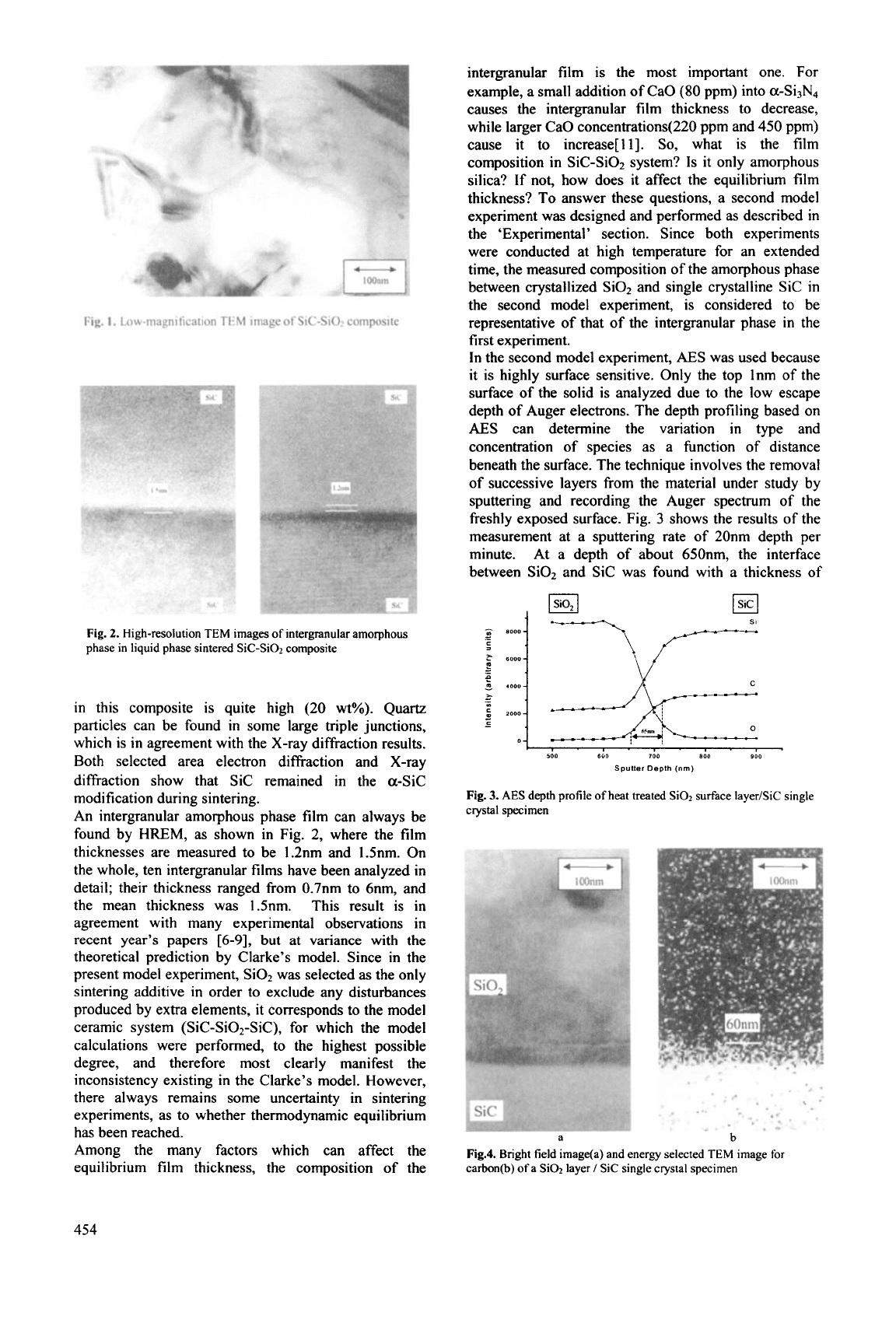
Fig.
1.
Low-magnification TEM image ofSiC-Si02 composite
Fig.
2.
High-resolution TEM images
of
intergranular amorphous
phase
in
liquid phase sintered Sic-SO2 composite
in this composite is quite high (20
wt%).
Quartz
particles can be found in some large triple junctions,
which is in agreement with the X-ray diffraction results.
Both selected area electron diffraction and X-ray
diffraction show that Sic remained in the a-Sic
modification during sintering.
An intergranular amorphous phase film can always be
found by
HEM,
as shown in Fig. 2, where the film
thicknesses are measured to be 1.2nm and 1.5nm.
On
the whole, ten intergranular films have been analyzed in
detail; their thickness ranged from 0.7nm to 6nm, and
the mean thickness was 1.5nm. This result is in
agreement with many experimental observations in
recent year’s papers
[6-91,
but at variance with the
theoretical prediction by Clarke’s model. Since in the
present model experiment, SiOz was selected as the only
sintering additive in order to exclude any disturbances
produced by extra elements, it corresponds to the model
ceramic system (SiC-Si02-SiC), for which the model
calculations were performed, to the highest possible
degree, and therefore most clearly manifest the
inconsistency existing in the Clarke’s model. However,
there always remains some uncertainty in sintering
experiments,
as
to whether thermodynamic equilibrium
has been reached.
Among the many factors which can affect the
equilibrium film thickness, the composition of the
intergranular film is the most important one. For
example, a small addition of CaO
(80
ppm) into a-Si3N4
causes the intergranular film thickness to decrease,
while larger CaO concentrations(220 ppm and 450 ppm)
cause it to increase[ll].
So,
what is the film
composition in SiC-Si02 system?
Is
it only amorphous
silica? If not, how does it affect the equilibrium film
thickness? To answer these questions, a second model
experiment was designed and performed as described
in
the ‘Experimental’ section. Since both experiments
were conducted at high temperature for an extended
time, the measured composition of the amorphous phase
between crystallized SiOz and single crystalline Sic in
the second model experiment, is considered to be
representative of that of the intergranular phase in the
first experiment.
In
the second model experiment,
AES
was used because
it is highly surface sensitive. Only the top lnm of the
surface of the solid is analyzed due to the low escape
depth of Auger electrons. The depth profiling based on
AES
can determine the variation in type and
concentration of species as a function of distance
beneath the surface. The technique involves the removal
of successive layers from the material under study by
sputtering and recording the Auger spectrum of the
freshly exposed surface. Fig.
3
shows the results of the
measurement at a sputtering rate of 20nm depth per
minute.
At a depth of about 650nm, the interface
between Si02 and Sic was found with a thickness of
I00
600
700
800
900
Sputter Depth
(nm)
Fig.
3.
AES depth profile
of
heat treated
SiO2
surface layer/SiC single
crystal specimen
a
b
Fig.4.
Bright field image(a) and energy selected TEM image
for
carbon(b) ofa SiO2 layer
/
Sic single crystal specimen
454
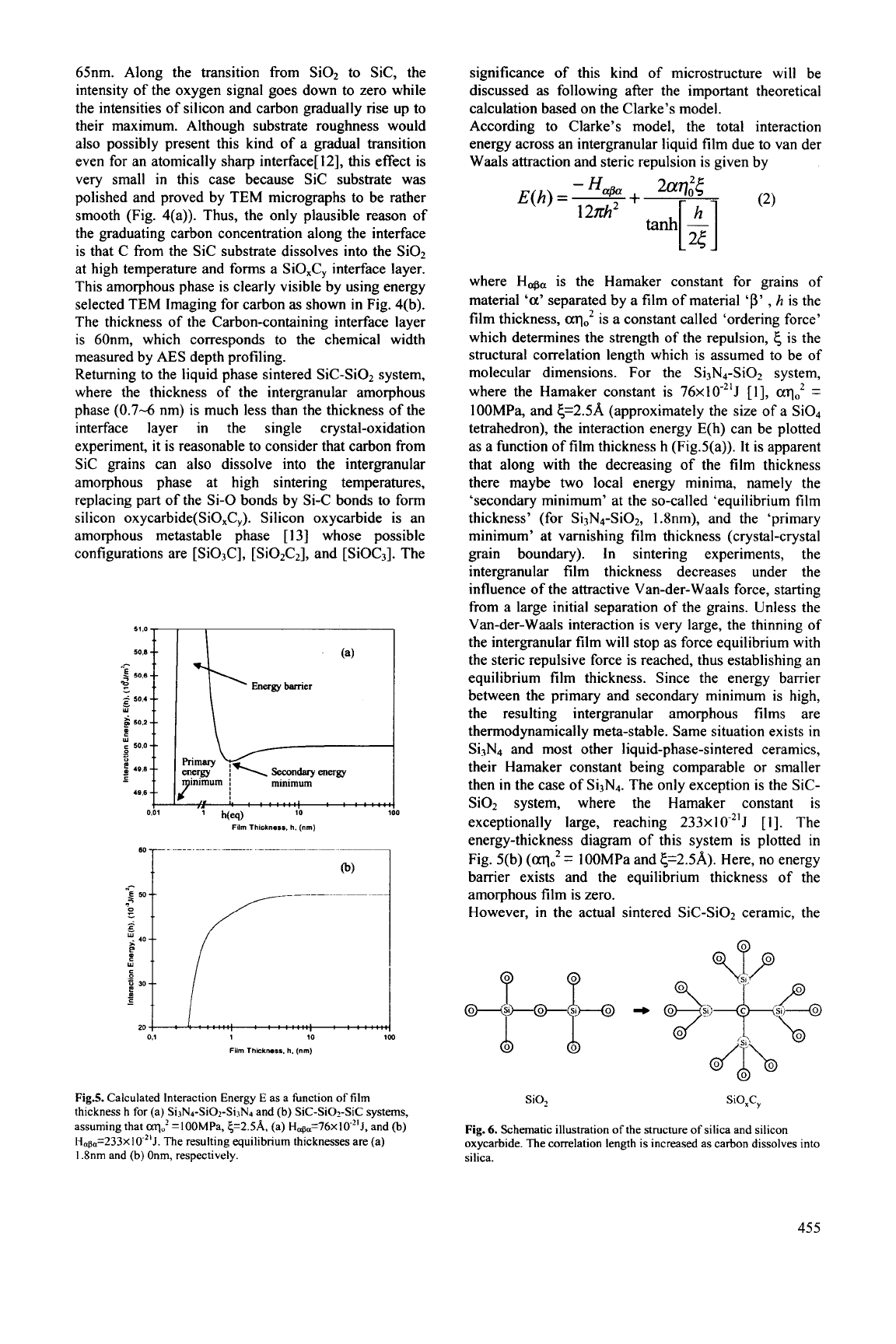
65nm. Along the transition from SiOz to Sic, the
intensity of the oxygen signal goes dohwn to zero while
the intensities of silicon and carbon gradually rise up to
their maximum. Although substrate roughness would
also possibly present this kind of a gradual transition
even for an atomically sharp interface[ 121, this effect is
very small in this case because Sic substrate was
polished and proved by TEM micrographs to be rather
smooth (Fig. 4(a)). Thus, the only plausible reason of
the graduating carbon concentration along the interface
is that C from the Sic substrate dissolves into the SiOz
at high temperature and forms a SiO,C, interface layer.
This amorphous phase is clearly visible by using energy
selected TEM Imaging for carbon
as
shown in Fig. 4(b).
The thickness of the Carbon-containing interface layer
is 60nm, which corresponds to the chemical width
measured by AES depth profiling.
Returning to the liquid phase sintered SiC-Si02 system,
where the thickness of the intergranular amorphous
phase (0.7-6 nm) is much less than the thickness of the
interface layer
in
the single crystal-oxidation
experiment, it is reasonable to consider that carbon from
Sic grains can also dissolve into the intergranular
amorphous phase at high sintering temperatures,
replacing part of the Si-0 bonds by Si-C bonds to form
silicon oxycarbide(SiO,C,). Silicon oxycarbide is an
amorphous metastable phase
[
131 whose possible
configurations are [SiO$], [Si02C2], and [SiOC3]. The
50.2
0.61
(a)
U
\
Energy barrier
ry
;.
,
.
,
.
,,.,
. . . .
, ,,
h(ea)
.
.I
Film
Thickness. h.
(nm)
significance of this kind of microstructure will be
discussed as following after the important theoretical
calculation based on the Clarke’s model.
According to Clarke’s model, the total interaction
energy across an intergranular liquid film due to van der
Waals attraction and steric repulsion is given by
L+
J
where
HN~
is the Hamaker constant for grains
of
material
‘a’
separated by a film of material
‘p’
,
h
is the
film thickness,
cq;
is a constant called ‘ordering force’
which determines the strength of the repulsion,
6
is the
structural correlation length which is assumed to be of
molecular dimensions.
For
the Si3N4-SiOz system,
where the Hamaker constant is 76~1O-~’J [I],
aq;
=
1
OOMPa, and E,=2.5A (approximately the size of a Si04
tetrahedron), the interaction energy E(h) can be plotted
as a function of film thickness h (Fig.S(a)). It is apparent
that along with the decreasing of the film thickness
there maybe
two
local energy minima, namely the
‘secondary minimum’ at the so-called ‘equilibrium film
thickness’ (for Si3N4-Si02, 1.8nm), and the ‘primary
minimum’ at varnishing film thickness (crystal-crystal
grain boundary). In sintering experiments, the
intergranular film thickness decreases under the
influence of the attractive Van-der-Waals force, starting
from a large initial separation of the grains. Unless the
Van-der-Waals interaction is very large, the thinning of
the intergranular film will stop as force equilibrium with
the steric repulsive force is reached, thus establishing an
equilibrium film thickness. Since the energy barrier
between the primary and secondary minimum is high,
the resulting intergranular amorphous films are
thermodynamically meta-stable. Same situation exists in
S&N4 and most other liquid-phase-sintered ceramics,
their Hamaker constant being comparable
or
smaller
then in the case of Si3N4. The only exception is the SiC-
Si02 system, where the Hamaker constant is
exceptionally large, reaching 233xlO-”J [I]. The
energy-thickness diagram of this system is plotted
in
Fig. 5(b)
(cq;
=
IOOMPa and E,=2.5A). Here, no energy
bamer exists and the equilibrium thickness of the
amorphous film is zero.
However, in the actual sintered SiC-Si02 ceramic, the
Fig5
Calculated Interaction Energy
E
as a hnction
of
film
thickness h
for
(a) Si3NAi02-Si3Ns and (b) SiC-SiO4iC systems,
assuming that
aq”’
=100MPa,
{=2.5A.
(a)
Hapa=76~10-21J,
and
(b)
I-I.,~~=233xlO~~’J.
The resulting equilibrium thicknesses are (a)
I
.8nm and (b) Onm, respectively.
SOz
SiO,C,
Fig.
6.
Schematic illustration
of
the structure
of
silica and silicon
oxycarbide. The correlation length
is
increased as carbon dissolves into
silica.
455
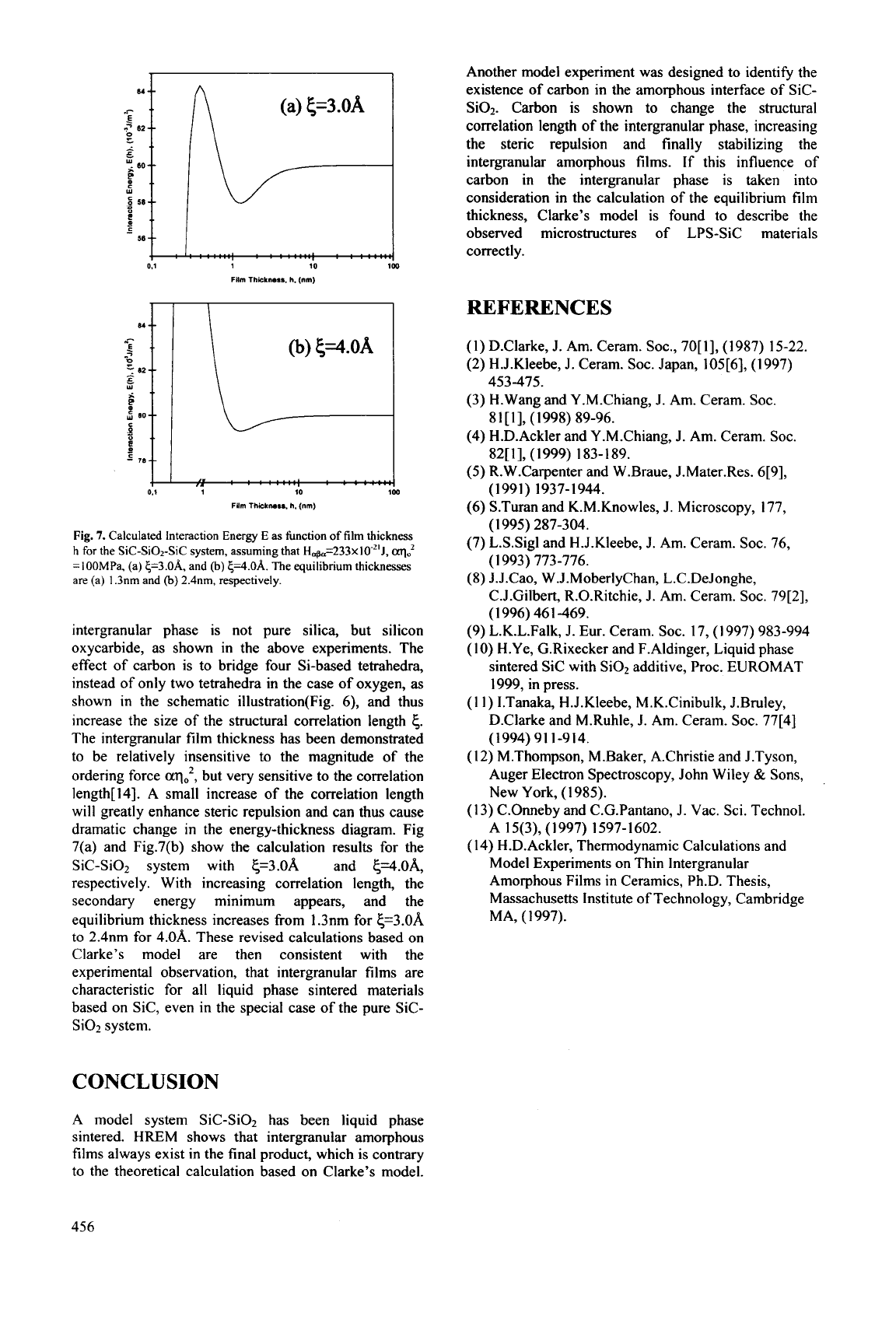
--
I
0.1
10
1W
Flm
Thickness.
h.
(nm)
0.1
10
100
Film
ThiCkM88,
h.
(nm)
Fig.
7.
Calculated Interaction Energy
E
as knction
of
film thickness
h
for
the SiC-SiO2-SiC system, assuming that
H+=233xIO-”J,
cqo’
=I
OOMPa, (a)
<=3.OA,
and (b)
<+.OA.
The
equilibrium thicknesses
are (a)
1.3nm
and
(b)
2.4nm.
respectively.
intergranular phase is not pure silica, but silicon
oxycarbide, as shown in the above experiments. The
effect of carbon is to bridge four Si-based tetrahedra,
instead of only two tetrahedra in the case of oxygen,
as
shown in the schematic illustration(Fig. 6), and thus
increase the size
of
the structural correlation length
5.
The intergranular film thickness has been demonstrated
to
be
relatively insensitive to the magnitude of the
ordering force
aq;,
but very sensitive to the correlation
length[l4]. A small increase of the correlation length
will greatly enhance steric repulsion and can thus cause
dramatic change in the energy-thickness diagram. Fig
7(a) and Fig.7(b) show the calculation results for the
Sic-Si02 system with 6=3.0A and
6=4.OA,
respectively. With increasing correlation length, the
secondary energy minimum appears, and the
equilibrium thickness increases from 1.3nm for 5=3.0A
to
2.4nm for 4.OA. These revised calculations based on
Clarke’s model are then consistent with the
experimental observation, that intergranular films are
characteristic for all liquid phase sintered materials
based on Sic, even in the special case of the pure Sic-
Si02 system.
CONCLUSION
Another model experiment was designed to identify the
existence
of
carbon in the amorphous interface of Sic-
SOz. Carbon is shown to change the structural
correlation length
of
the intergranular phase, increasing
the steric repulsion and finally stabilizing the
intergranular amorphous films.
If
this influence of
carbon in the intergranular phase is taken into
consideration in the calculation of the equilibrium film
thickness, Clarke’s model is found to describe the
observed microstructures of LPS-Sic materials
correctly.
REFERENCES
(1)
D.Clarke,
J.
Am. Ceram. SOC., 70[ 13, (1987) 15-22.
(2) H.J.Kleebe, J. Ceram. SOC. Japan, 105[6], (1 997)
(3) H.Wang and Y.M.Chiang, J. Am. Ceram. SOC.
(4) H.D.Ackler and Y.M.Chiang, J. Am. Ceram. SOC.
(5)
R.W.Carpenter and W.Braue, J.Mater.Res. 6[9],
(6) S.Turan and K.M.Knowles, J. Microscopy, 177,
(7) L.S.Sigl and H.J.Kleebe, J. Am. Ceram. SOC. 76,
(8)
J. J .Cao, W.
J
.Moberl yChan,
L
.C.DeJonghe,
453-475.
81[1], (1998) 89-96.
82[1], (1999) 183-189.
(1 991) 1937-1 944.
(1 995) 287-304.
(1993) 773-776.
C.J.Gilbert, R.O.Ritchie, J. Am. Ceram. SOC. 79[2],
(1996) 461-469.
(9) L.K.L.Falk, J. Eur. Ceram. SOC. 17, (1997) 983-994
(10)
H.Ye, G.Rixecker and F.Aldinger, Liquid phase
sintered Sic with SiOz additive, Proc. EUROMAT
1999, in press.
D.Clarke and M.Ruhle, J. Am. Ceram. SOC. 77[4]
(1
2) M.Thompson, M.Baker, A.Christie and J.Tyson,
(1 1)
I.Tanaka, H.J.Kleebe, M.K.Cinibulk, J.Bruley,
(1994) 91 1-914.
Auger Electron Spectroscopy, John Wiley
&
Sons,
New York, (1 985).
(13) C.Onneby and C.G.Pantano,
J.
Vac. Sci. Technol.
(14)
H.D.Ackler, Thermodynamic Calculations and
Model Experiments on Thin Intergranular
Amorphous Films in Ceramics, Ph.D. Thesis,
Massachusetts Institute of Technology, Cambridge
MA,
(1
997).
A 15(3),
(1
997) 1597-1 602.
A
model system Sic-SiO2 has been liquid phase
sintered. HREM shows that intergranular amorphous
films always exist
in
the final product, which is contrary
to the theoretical calculation based on Clarke’s model.
456
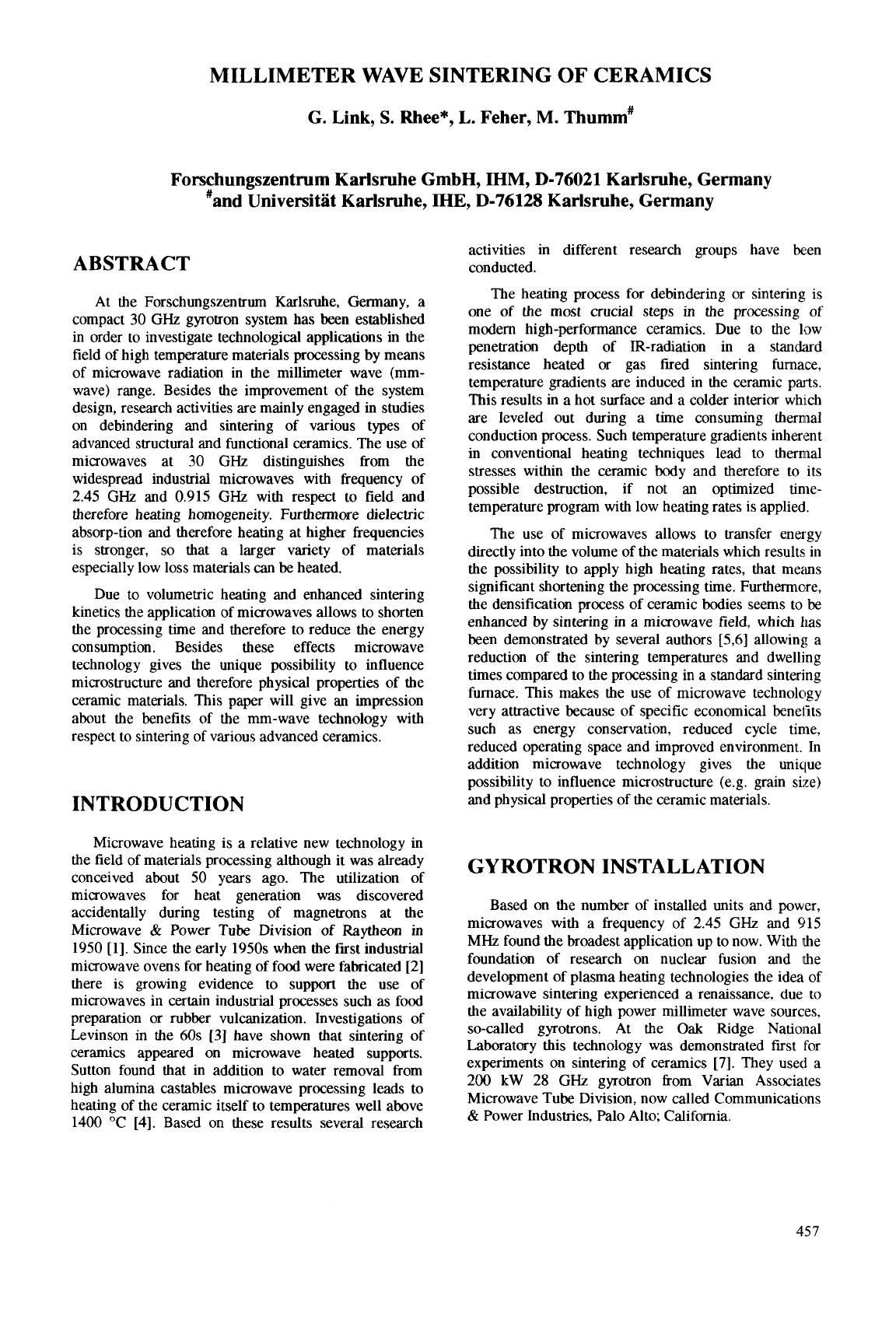
MILLIMETER WAVE SINTERING
OF
CERAMICS
G. Link,
S.
Wee*,
L.
Feher,
M.
Thumm'
Forschungszentrum Karlsruhe GmbH,
IHM,
D-76021
Karlsruhe, Germany
and Universitat Karlsruhe,
#
ABSTRACT
At
the Forschungszentrum Karlsruhe, Germany, a
compact
30
GHz gyrotron system has been established
in order to investigate technological applications in the
field of high temperature materials processing by means
of microwave radiation in the millimeter wave (mm-
wave) range. Besides the improvement of the system
design, research activities are mainly engaged in studies
on debindering and sintering of various types of
advanced structural and functional ceramics. The use of
microwaves at
30
GHz
distinguishes from the
widespread industrial microwaves with frequency of
2.45
GHz
and 0.915
GHz
with respect to field and
therefore heating homogeneity. Furthermore dielectric
absorp-tion and therefore heating at higher frequencies
is stronger,
so
that a larger variety of materials
especially low loss materials can be heated.
Due to volumetric heating and enhanced sintering
kinetics the application of microwaves allows to shorten
the processing time and therefore to reduce the energy
consumption. Besides these effects microwave
technology gives the unique possibility to influence
microstructure and therefore physical properties of the
ceramic materials. This paper will give
an
impression
about the benefits of the mm-wave technology with
respect to sintering of various advanced ceramics.
INTRODUCTION
Microwave heating is a relative new technology in
the field of materials processing although it was already
conceived about
50
years ago. The utilization of
microwaves for heat generation was discovered
accidentally during testing of magnetrons at the
Microwave
&
Power Tube Division
of
Raytheon in
1950 [l]. Since the early 1950s when the first industrial
microwave ovens for heating of food were fabricated
[2]
there is growing evidence
to
support the use
of
microwaves in certain industrial processes such as food
preparation or rubber vulcanization. Investigations of
Levinson in the
60s
[3] have shown that sintering of
ceramics appeared on microwave heated supports.
Sutton found that in addition to water removal from
high alumina castables microwave processing leads to
heating of the ceramic itself to temperatures well above
1400 "C [4]. Based on these results several research
IHE,
D-76128
Karlsruhe, Germany
activities in different research groups have been
conducted.
The heating process for debindering or sintering is
one
of
the most crucial steps in the processing of
modern high-performance ceramics. Due to the low
penetration depth of IR-radiation in a standard
resistance heated
or
gas fired sintering furnace,
temperature gradients are induced in the ceramic parts.
This results in a hot surface and a colder interior whiich
are leveled out during a time consuming thermal
conduction process. Such temperature gradients inherent
in conventional heating techniques lead to thermal
stresses within the ceramic body and therefore to its
possible destruction, if not an optimized time-
temperature program with low heating rates is applied.
The use of microwaves allows to transfer energy
directly into the volume of the materials which results in
the possibility to apply high heating rates, that means
significant shortening the processing time. Furthermore,
the densification process of ceramic bodies seems to be
enhanced by sintering in a microwave field, which has
been demonstrated by several authors [5,6] allowing a
reduction of the sintering temperatures and dwelling
times compared to the processing in a standard sintering
furnace. This makes the use of microwave technolclgy
very attractive because of specific economical benelits
such as energy conservation, reduced cycle time,
reduced operating space and improved environment.
In
addition microwave technology gives the unique
possibility to influence microstructure (e.g. grain size)
and physical properties of the ceramic materials.
GYROTRON INSTALLATION
Based on the number of installed units and power,
microwaves with a frequency of 2.45
GHz
and
915
MHz found the broadest application up to now. With the
foundation of research on nuclear fusion and
ithe
development of plasma heating technologies the idea of
microwave sintering experienced a renaissance, due
to
the availability of high power millimeter wave sources,
so-called gyrotrons.
At
the
Oak
Ridge National
Laboratory this technology was demonstrated first for
experiments on sintering
of
ceramics
[7].
They used a
200 kW
28
GHz
gyrotron from Varian Associates
Microwave Tube Division, now called Communications
&
Power Industries, Palo Alto; California.
457
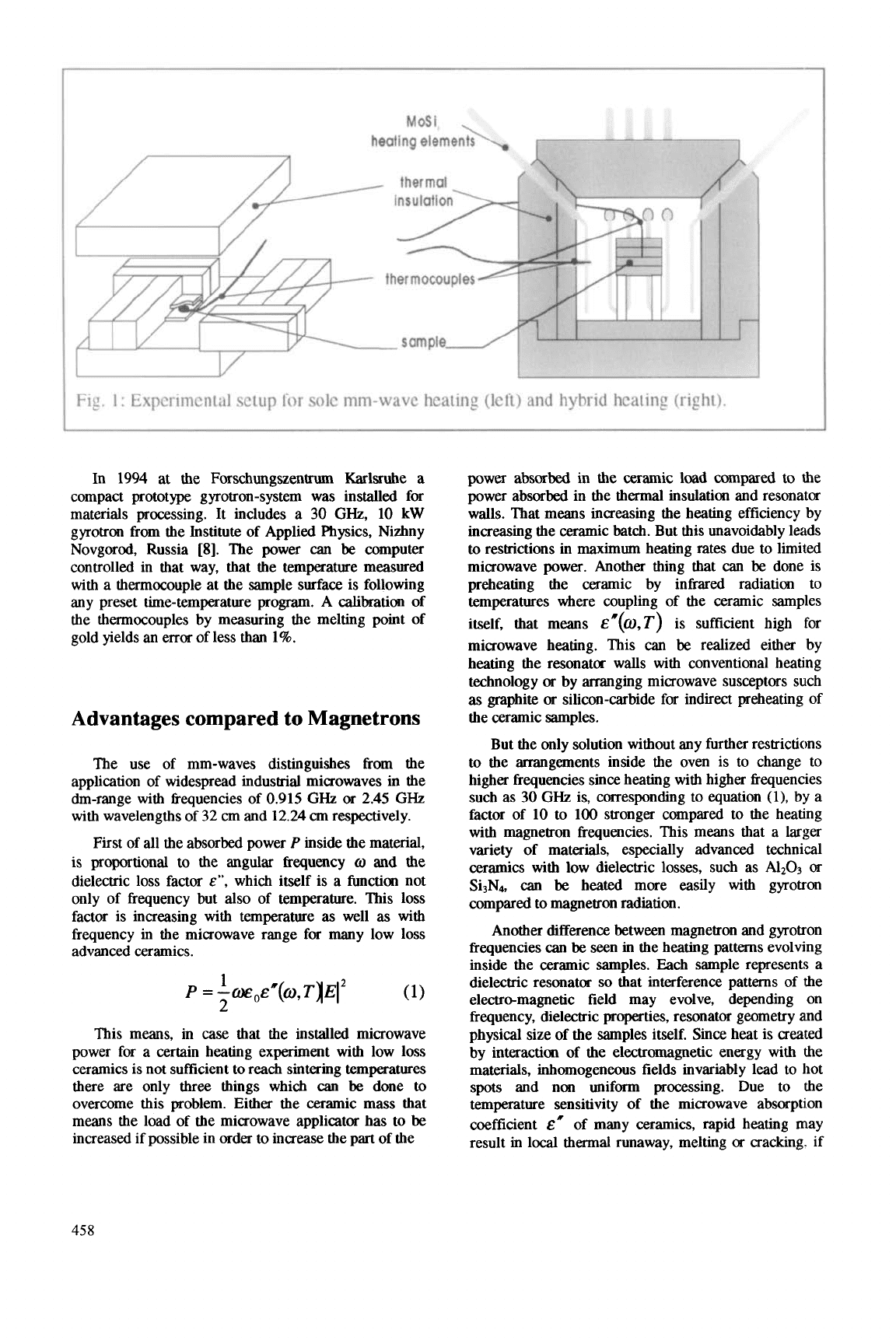
Fig.
1:
Experimental setup
for
sole
mm-wave heating (left) and hybrid heating (right).
In 1994 at the Forschungszentrum Karlsruhe a
compact prototype gyrotron-system was installed for
materials processing. It includes
a
30
GHz,
10
kW
gyrotron from the Institute of Applied Physics, Nizhny
Novgorod, Russia
[8].
The power
can
be
computer
controlled in that way, that the temperature measured
with
a thermocouple at the sample surface is following
any preset time-temperature program. A calibration
of
the thermocouples by measuring the melting point
of
gold yields
an
error of less than
1%.
Advantages compared to Magnetrons
The use of mm-waves distinguishes from the
application of widespread industrial microwaves in the
dm-range with frequencies of
0.915
GHz
or
2.45
GHz
with wavelengths of 32
cm
and 12.24
cm
respectively.
First of all the absorbed power
P
inside the material,
is
proportional to the angular frequency
o
and
the
dielectric loss factor
&",
which itself is a function not
only of frequency but
also
of temperature. This loss
factor is increasing with temperature
as
well
as
with
frequency in the microwave range for many low loss
advanced ceramics.
L
This means, in case that the installed microwave
power for a certain heating experiment with low loss
ceramics is not sufficient to reach sintering temperatures
there are only three things which
can
be done to
overcome this problem. Either the ceramic mass that
means the load
of
the microwave applicator has to be
increased if possible in order to increase the part of the
power absorbed in the ceramic
load
compared
to
the
power absorbed in the thermal insulation and resonator
walls. That means increasing the heating efficiency by
increasing the ceramic batch. But this unavoidably leads
to restrictions in
maximum
heating rates due to limited
microwave power. Another thing that
can
be
done is
preheating the ceramic by infrared radiation to
temperatures where coupling of the ceramic samples
itself, that means
E"(W,T)
is sufficient high for
microwave heating. This
can
be
realized either by
hating the resonator walls with conventional heating
technology
or
by arranging microwave susceptors such
as
graphite
or
silicon-carbide for indirect preheating of
the ceramic samples.
But the only solution without any further restrictions
to the arrangements inside the oven is to change to
higher frequencies since heating with higher kequencies
such as
30
GHz
is, corresponding to equation
(l),
by a
factor of
10
to
100
stronger compared to the heating
with magnetron frequencies. This means that a larger
variety
of
materials, especially advanced technical
ceramics with low dielectric losses, such as Al203
or
Si3N4,
can
be
heated more easily with gyrotron
compared to magnetron radiation.
Another difference between magnetron and gyrotron
frequencies
can
be seen in
the
heating patterns evolving
inside the ceramic samples. Each sample represents a
dielectric resonator
so
that interference patterns of the
electremagnetic field may evolve, depending on
frequency, dielectric properties, resonator geometry and
physical size
of
the samples itself. Since heat is created
by interaction of the electromagnetic energy with the
materials, inhomogeneous fields invariably lead to hot
spots and non uniform processing. Due to the
temperature sensitivity
of
the microwave absorption
coefficient
El
of many ceramics, rapid heating may
result in local thermal runaway, melting
or
cracking. if
458
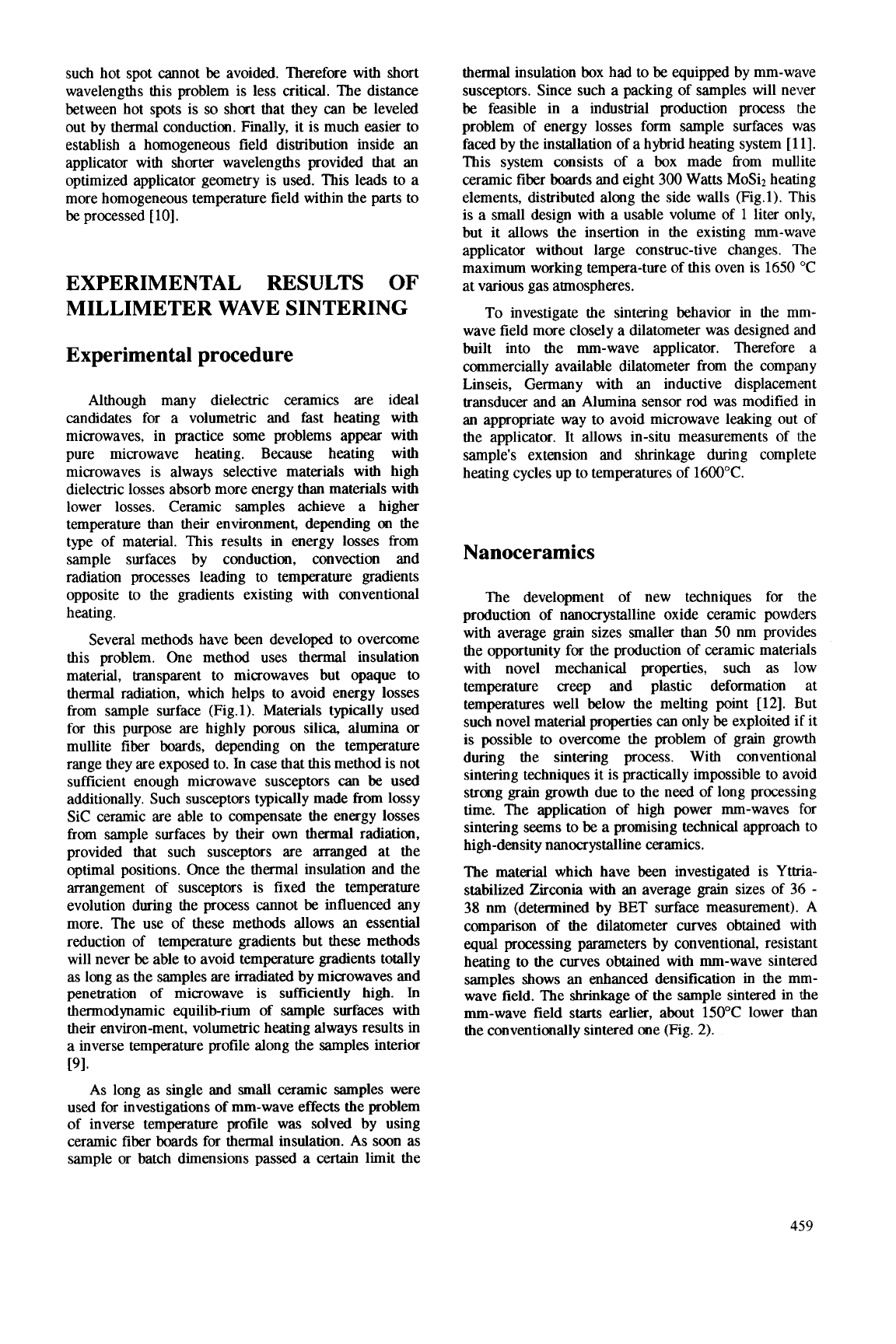
such hot spot cannot be avoided. Therefore with short
wavelengths this problem is less critical. The distance
between hot spots is
so
short that they can be leveled
out by thermal conduction. Finally, it is much easier to
establish a homogeneous field distribution inside an
applicator with shorter wavelengths provided that an
optimized applicator geometry is used. This leads to a
more homogeneous temperature field within the parts to
be processed
[
101.
EXPERIMENTAL RESULTS
OF
MILLIMETER WAVE SINTERING
Experimental procedure
Although many dielectric ceramics are ideal
candidates for a volumetric and fast heating with
microwaves, in practice some problems appear with
pure microwave heating. Because heating with
microwaves is always selective materials with high
dielectric losses absorb more energy than materials with
lower losses. Ceramic samples achieve a higher
temperature than their environment, depending
on
the
type of material. This results in energy losses from
sample surfaces by conduction, convection and
radiation processes leading to temperature gradients
opposite to the gradients existing with conventional
heating.
Several methods have been developed to overcome
this problem. One method uses thermal insulation
material, transparent to microwaves but opaque to
thermal radiation, which helps to avoid energy losses
from sample surface (Fig.1). Materials typically used
for this purpose are highly porous silica, alumina
or
mullite fiber boards, depending on the temperature
range they are exposed to. In case that this method is not
sufficient enough microwave susceptors
can
be used
additionally. Such susceptors typically made from lossy
Sic ceramic are able to compensate the energy losses
from sample surfaces by their
own
thennal radiation,
provided that such susceptors are arranged at the
optimal positions. Once the thermal insulation and the
arrangement of susceptors is fixed the temperature
evolution during the process cannot be influenced any
more. The use of these methods allows an essential
reduction of temperature gradients but these methods
will never be able to avoid temperature gradients totally
as long as the samples are irradiated by microwaves and
penetration
of
microwave
is
sufficiently high. In
thermodynamic equilib-rium of sample surfaces
with
their environ-ment, volumetric heating always results in
a inverse temperature profile along the samples interior
As long as single and small ceramic samples were
used for investigations of mm-wave effects the problem
of inverse temperature profile was solved by using
ceramic fiber boards for thermal insulation.
As
soon as
sample or batch dimensions passed a certain limit the
[91.
thermal insulation box had to be equipped by mm-wave
susceptors. Since such a packing of samples will never
be
feasible in a industrial production process the
problem of energy losses form sample surfaces was
faced by the installation
of
a hybrid heating system
[
111.
This system consists of a box made f?om mullite
ceramic fiber boards and eight 300 Watts MoSiz heating
elements, distributed along the side walls (Fig.1). This
is a small design with a usable volume of 1 liter only,
but it allows the insertion in the existing mm-wave
applicator without large construc-tive changes. The
maximum working tempera-ture of this oven is 1650
"C
at various gas atmospheres.
To investigate the sintering behavior in the mm-
wave field more closely a dilatometer was designed and
built into the mm-wave applicator. Therefore a
commercially available dilatometer from the company
Linseis, Germany with an inductive displacement
transducer and an Alumina sensor rod was modified in
an appropriate way to avoid microwave leaking out of
the applicator. It allows in-situ measurements of Ihe
sample's extension and shrinkage during complete
heating cycles up to temperatures of 1600°C.
Nanoceramics
The development of new techniques for the
production of nanocrystalline oxide ceramic powders
with average grain sizes smaller than
50
nm provides
the opportunity for the production of ceramic materials
with novel mechanical properties, such as low
temperature creep and plastic deformation at
temperatures well below the melting point [12].
But
such novel material properties
can
only
be
exploited if it
is possible to overcome the problem of grain growth
during the sintering process. With conventional
sintering techniques it is practically impossible to avoid
strong
grain
growth due to the need of long processing
time. The application of high power mm-waves for
sintering seems to be a promising technical approach
to
high-density nanocrystalline ceramics.
The material which have been investigated is Yttria-
stabilized Zirconia with
an
average grain sizes of 36
-
38 nm (determined by BET surface measurement).
A
comparison of the dilatometer curves obtained with
equal processing parameters by conventional, resistant
heating to the curves obtained with mm-wave sintered
samples shows an enhanced densification in the mm-
wave field. The shrinkage of the sample sintered in the
mm-wave field
starts
earlier, about 150°C lower than
the conventionally sintered one (Fig. 2).
459
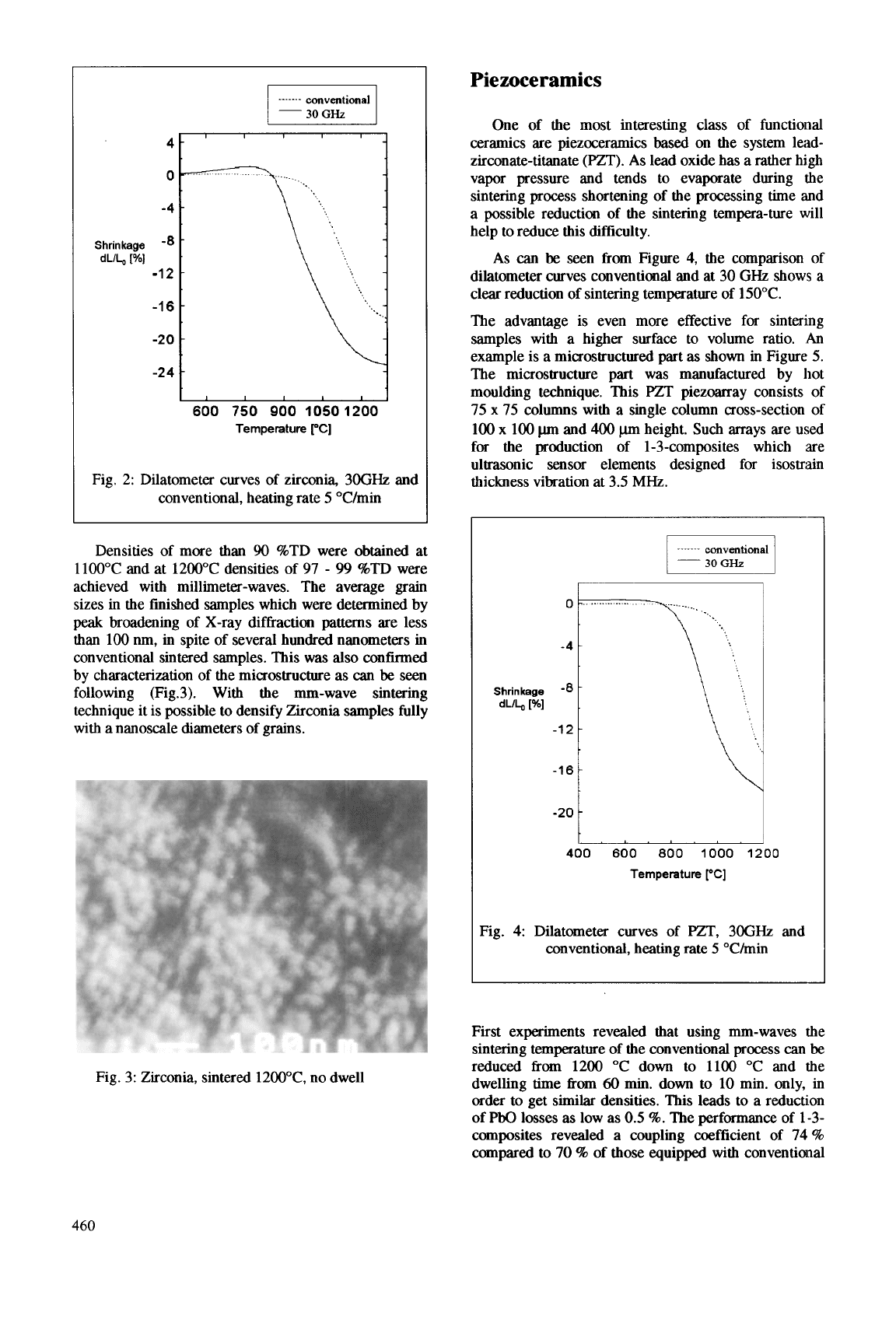
conventional
._.
. .
.
.
1
-3OGHz
41
Shrinkage
dL/b
[%]
-20
-2
4
I
600
750
900
1050
1200
Temperature
["C]
Fig. 2: Dilatometer curves of zirconia, 3OGHz and
conventional, heating rate 5 "C/min
Densities
of
more than
90
%TD were obtained at
1100°C and at 1200°C densities of 97
-
99
%TD were
achieved with millimeter-waves. The average grain
sizes in the finished samples which were determined by
peak
broadening of X-ray diffraction patterns
are
less
than 100 nm, in spite of several hundred nanometers in
conventional sintered samples. This was also
confumed
by characterization of the microstructure as
can
be
seen
following (Fig.3). With the mm-wave sintering
technique it is possible to densify Zirconia samples fully
with a nanoscale diameters of grains.
Fig. 3: Zirconia, sintered 1200"C, no dwell
Piezoceramics
One of the most interesting class of functional
ceramics
are
piezoceramics based
on
the system leiid-
zirconate-titanate (PZT).
As
lead oxide has a rather high
vapor pressure and tends to evaporate during the
sintering process shortening
of
the processing time and
a
possible reduction
of
the sintering tempera-ture will
help to reduce this difficulty.
As
can
be
seen from Figure 4, the comparison of
dilatometer curves conventional and at 30
GHz
shows a
clear reduction of sintering temperature of 150°C.
The advantage is even more effective for sintering
samples with a higher surface to volume ratio.
An
example is a microstructured part
as
shown
in Figure 5.
The microstructure part was manufactured by hot
moulding technique. This PZT piezoarray consists of
75 x 75 columns with a single column cross-section of
100
x
100
pm
and 400
p
height. Such arrays are used
for the production of 1-3-composites which
xe
ultrasonic
sensor
elements designed for isostriain
thickness vibration at 3.5
MHz.
conventional
. .
.
. .
.
.
~
-3OGHz
1
0
-4
Shrinkage
-8
dLIb
[%]
-1
2
-1
6
-20
400
600
800
1000
1200
Temperature ["C]
Fig. 4: Dilatometer curves
of
PZT, 3OGHz and
conventional, heating
rate
5
"C/min
First experiments revealed that using mm-waves the
sintering temperature
of
the conventional process
can
be
reduced from
1200
"C
down to 1100 "C and the
dwelling time from
60
min. down to 10 min. only, in
order to get
similar
densities. This leads to a reduction
of
PbO
losses
as
low as 0.5
%.
The performance of 1-3-
composites revealed a coupling coefficient of 74%
compared
to
70
%
of those equipped with conventional
460
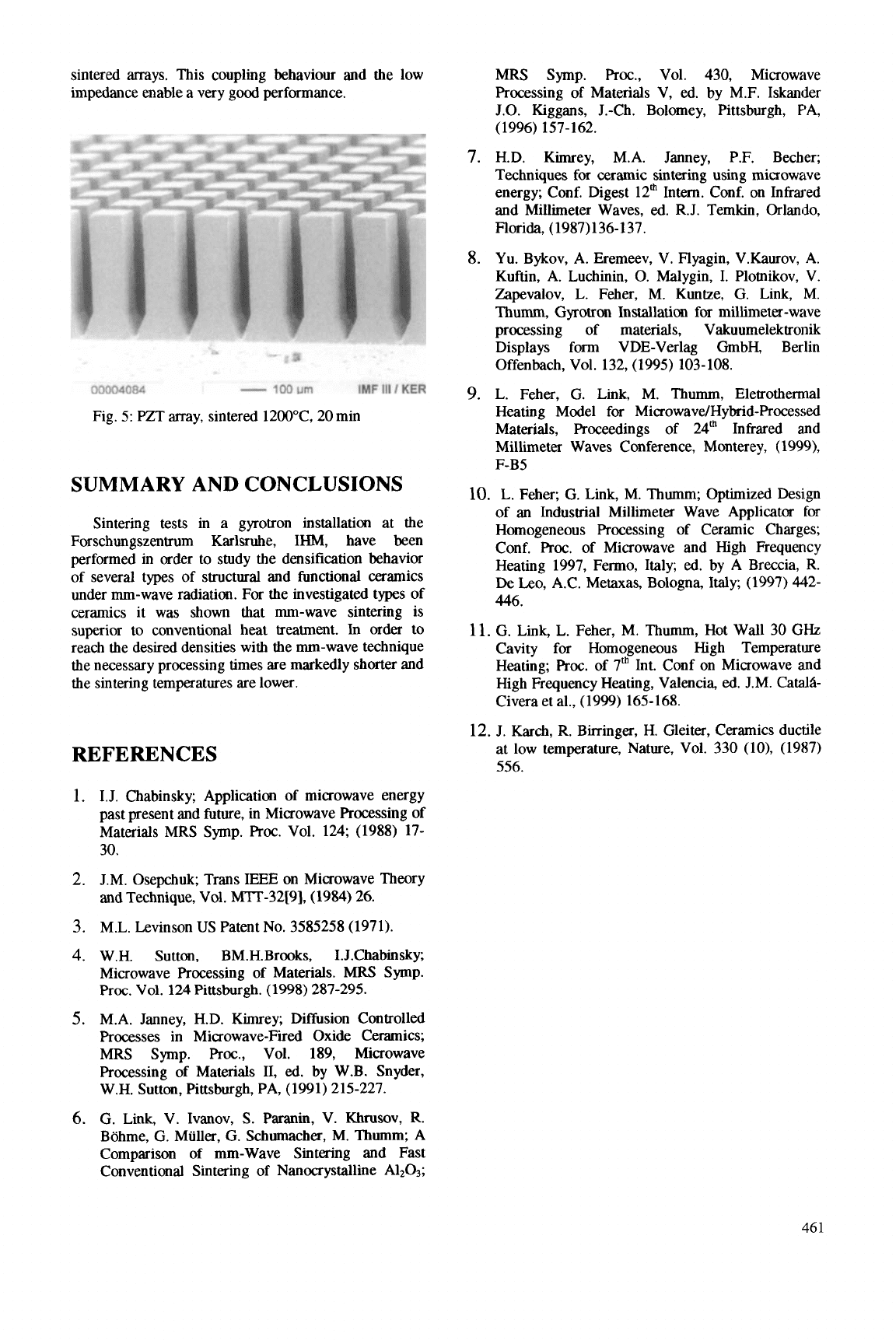
sintered arrays. This coupling behaviour and the low
impedance enable
a
very
good
performance.
Fig.
5:
PZT array, sintered 120O0C, 20 min
SUMMARY AND CONCLUSIONS
Sintering tests in a gyrotron installation at the
Forschungszentrum Karlsruhe, IHM, have been
performed in order to study the densification behavior
of several types of structural and functional ceramics
under mm-wave radiation. For the investigated types of
ceramics it was
shown
that mm-wave sintering is
superior to conventional heat treatment.
In
order
to
reach the desired densities with the mm-wave technique
the necessary processing times are markedly shorter and
the sintering temperatures are lower.
REFERENCES
1.
2.
3.
4.
5.
6.
I.J. Chabinsky; Application of microwave energy
past present and future, in Microwave Processing of
Materials MRS Symp.
Roc.
Vol. 124; (1988) 17-
30.
J.M. Osepchuk; Trans IEEE on Microwave Theory
and
Technique, Vol. MlT-32[9],
(1984)
26.
M.L. Levinson
US
Patent No. 3585258 (1971).
W.H. Sutton, BM.H.Brooks, 1.J.Chabinsky;
Microwave Processing of Materials. MRS Symp.
Roc.
Vol.
124
Pittsburgh.
(1998)
287-295.
M.A. Janney, H.D. Kimrey; Diffusion Controlled
Processes in Microwave-Fired Oxide Ceramics;
MRS Symp. Proc., Vol. 189, Microwave
Processing of Materials 11,
ed.
by W.B. Snyder,
W.H. Sutton, Pittsburgh, PA, (1991) 215-227.
G. Link, V. Ivanov,
S.
Paranin, V. Khrusov, R.
Bohme,
G.
Miiller,
G.
Schumacher, M. Thumm; A
Comparison of mm-Wave
Sintering
and Fast
Conventional Sintering
of
Nanocrystalline
Al203;
7.
8.
9.
10.
11.
12.
MRS Symp. Proc., Vol. 430, Microwave
Processing
of
Materials V, ed. by M.F. Iskander
J.O. Kiggans, J.-Ch. Bolomey, Pittsburgh, PA,
H.D. Kimrey, M.A. Janney, P.F. Becher;
Techniques for ceramic sintering using microwave
energy; Conf. Digest 12" Intern. Conf. on Infrared
and Millimeter Waves,
ed.
R.J. Temkin, Orlando,
Florida,
(1987)136-137.
Yu. Bykov, A. Eremeev, V. Flyagin, V.Kaurov, A.
Kuftin, A. Luchinin,
0.
Malygin, I. Plomikov, V.
Zapevalov, L. Feher, M. Kuntze,
G.
Link, M.
Thumm,
Gyrotron
Installation for millimeter-wave
processing of materials, Vakuumelektronik
Displays form VDE-Verlag GmbH, Berlin
Offenbach, Vol. 132,
(1995)
103-108.
L. Feher,
G.
Link, M. Thumm, Eletrothermal
Heating Model for
Microwave/Hybrid-Processed
Materials, Proceedings of 24'h Infrared and
Millimeter Waves Conference, Monterey,
(1999),
L. Feher;
G.
Link, M. Thumm; Optimized Design
of an Industrial Millimeter Wave Applicator for
Homogeneous Processing
of
Ceramic Charges;
Conf.
Roc.
of Microwave and High Frequency
Heating 1997, Fermo, Italy;
ed.
by A Breccia, R.
De
Leo,
A.C. Metaxas, Bologna, Italy; (1997) 442-
446.
G. Link, L. Feher, M. Thumm, Hot Wall 30
GHz
Cavity for Homogeneous High Temperature
Heating; Roc. of 7'h Int. Conf on Microwave and
High Frequency Heating, Valencia,
ed.
J.M. CatalA-
Civera et al., (1999) 165-168.
J. Karch, R. Birringer, H. Gleiter, Ceramics ductile
at low temperature, Nature, Vol. 330
(lo),
(1987)
556.
(1996) 157-162.
F-B5
46
I
